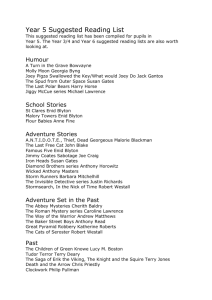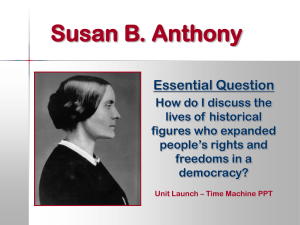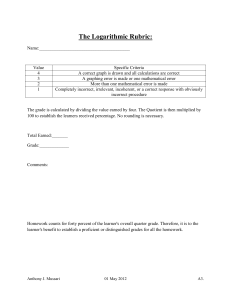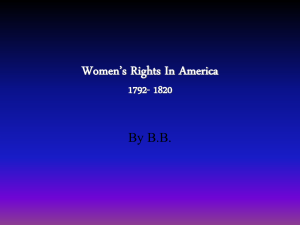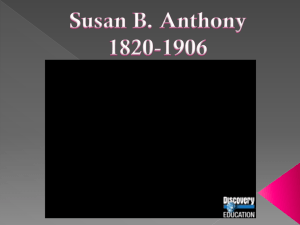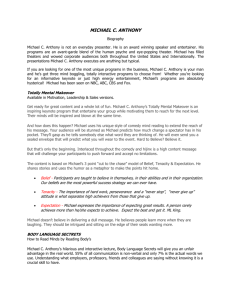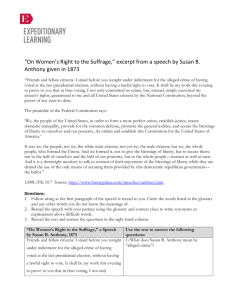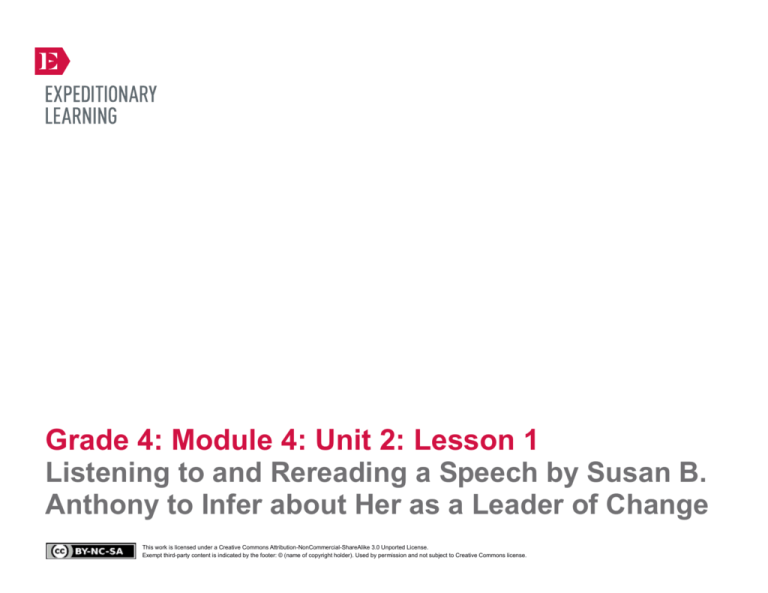
Grade 4: Module 4: Unit 2: Lesson 1
Listening to and Rereading a Speech by Susan B.
Anthony to Infer about Her as a Leader of Change
This work is licensed under a Creative Commons Attribution-NonCommercial-ShareAlike 3.0 Unported License.
Exempt third-party content is indicated by the footer: © (name of copyright holder). Used by permission and not subject to Creative Commons license.
GRADE 4: MODULE 4: UNIT 2: LESSON 1
Listening to and Rereading a Speech by Susan B. Anthony to Infer about
Her as a Leader of Change
Long-Term Targets Addressed (Based on NYSP12 ELA CCLS)
I can make inferences using specific details from the text. (RI.4.1)
I can adjust my writing practices for different time frames, tasks, purposes, and audiences. (W.4.10)
I can identify the reason a speaker provides to support a particular point. (SL.4.3)
Supporting Learning Targets
Ongoing Assessment
• I can make inferences using specific details from the text. (RI.4.1)
• Written Conversation papers
• I can adjust my writing practices for different time frames, tasks, purposes, and audiences. (W.4.10)
• Close Read recording form
• I can identify the reason a speaker provides to support a particular point. (SL.4.3)
Copyright © 2013 by Expeditionary Learning, New York, NY. All Rights Reserved.
NYS Common Core ELA Curriculum • G4:M4:U2:L1 • June 2014 •
1
GRADE 4: MODULE 4: UNIT 2: LESSON 1
Listening to and Rereading a Speech by Susan B. Anthony to Infer about
Her as a Leader of Change
Agenda
Teaching Notes
1. Opening
• In this lesson, students revisit the speech “On Women’s Right to the Suffrage” by Susan B. Anthony.
They listen to and then reread the first paragraph to infer what made Susan B. Anthony a leader of
change.
A. Reviewing Learning Targets (5 minutes)
B. Engaging the Reader: Written Conversation on a
Guiding Question (10 minutes)
2. Work Time
A. Listening to a Speech by Susan B. Anthony (20
minutes)
B. Rereading Susan B. Anthony’s Speech and
Answering Text-Dependent Questions (15 minutes)
3. Closing and Assessment
A. Exit Ticket: Written Conversation (10 minutes)
4. Homework
A. Write a short response
B. Provide at least two reasons to support your opinion
• To prepare for this close read of Anthony’s speech, students discuss their opinions about what makes
someone a “leader of change.”
• The linked audio file(used with permission from http://www.learnoutloud.com/Free-AudioVideo/History/Speeches/Speech-on-Womens-Right-to-Vote/22919) is a professional narration of the
speech that allows students to hear what the speech may have sounded like as it was given. Please note
that the website does contain advertisements which may or may not contain appropriate content. Be
sure to preview links.
• Because students will consider how delivering a passionate speech can be an act of leadership, hearing
the speech performed (as opposed to read) is important.
• If you do not have the technology available to play the audio file, consider having a drama teacher or
professional speaker come in to perform the speech.
• Also in this lesson, students will discuss the guiding question, “What makes someone a leader of
change?” in a Written Conversation. To do this, students work with a partner. Each student writes an
answer to the question. Next, they trade papers and respond in writing to each other’s answer. Students
then trade papers once more and read their partner’s response. They hold on to their papers for the
Closing, when they reflect on the question after experiencing the lesson. This Written Conversation
allows students to practice their writing fluency.
• In advance: Record the Written Conversation directions on the board if you don’t intend to use a
document camera or distribute the handout. Prepare a computer with speakers to play the speech for
students; review the Written Conversation protocol (Appendix).
• Post: Learning targets.
Copyright © 2013 by Expeditionary Learning, New York, NY. All Rights Reserved.
NYS Common Core ELA Curriculum • G4:M4:U2:L1 • June 2014 •
2
GRADE 4: MODULE 4: UNIT 2: LESSON 1
Listening to and Rereading a Speech by Susan B. Anthony to Infer about
Her as a Leader of Change
Lesson Vocabulary
Materials
opinion, leader, infer; alleged, denied,
committed, exercised, indictment,
lawful, right, suffrage (review from
Unit 1, Lesson 2
• Lined paper (two pieces per pair)
• Written Conversation directions (one per pair or one to display)
• Document camera
• Guiding Questions anchor chart (from Unit 1, Lesson 1)
• Close Read recording form (one per student)
• Computer with internet access and speakers
• Audio recording of “On Women’s Right to the Suffrage” narrated by Antonia Bath
http://www.learnoutloud.com/Free-Audio-Video/History/Speeches/Speech-on-Womens-Right-to-Vote/22919
• “On Women’s Right to the Suffrage” by Susan B. Anthony (from Unit 1, Lesson 2; one per student)
• Close Readers Do These Things anchor chart (from Unit 1, Lesson 2)
Opening
Meeting Students’ Needs
A. Reviewing Learning Targets (5 minutes)
• Direct students’ attention to the learning targets and read them aloud:
• To further support ELLs or students
who struggle with writing, consider
giving time in advance or additional
time to write an initial response to
the guiding question for the Written
Conversation. If you have students
who speak little to no English,
consider partnering them with a
speaker of their home language and
making this activity conversationbased.
* “I can respond in writing to a partner’s ideas..”
* “I can infer why Susan B. Anthony wrote and delivered ‘On Women’s Right to the Suffrage’”.
• Circle the words respond and conversation in the first target. Ask students to think about what each word means. Cold call a
few students to share their explanations.
• Tell students that respond means “to answer in writing or speech.” Explain that the root word for conversation is converse,
and this word is made up of two parts: con, meaning “together,” and verse, meaning “to speak,” so students will be
answering a question in writing together.
• Ask for a few volunteers to explain the second target in their own words. Listen for answers like: “We will reread Susan B.
Anthony’s speech and think about how she was a leader.” Clarify this target if necessary.
Copyright © 2013 by Expeditionary Learning, New York, NY. All Rights Reserved.
NYS Common Core ELA Curriculum • G4:M4:U2:L1 • June 2014 •
3
GRADE 4: MODULE 4: UNIT 2: LESSON 1
Listening to and Rereading a Speech by Susan B. Anthony to Infer about
Her as a Leader of Change
Meeting Students’ Needs
Opening (continued)
B. Engaging the Reader: Written Conversation on a Guiding Question (10 minutes)
• Write the guiding question, “What makes someone a leader of change?” on the board. Place students with a partner and
ensure that each student has a piece of lined paper. Tell them that they will have a Written Conversation. Give students a
copy of the Written Conversation directions, display a copy on a document camera, or post them on the board (see
supporting materials).
• Clarify the directions or model as needed. Give students 5 minutes for their Written Conversation. Ask a few to share their
partner’s written response. Listen for students to describe “leaders of change” in these ways: “someone who helps change
unfair rules,” “someone who is brave,” “someone who helps others,” or “someone who stands up for what he or she believes
in.”
• Add any new thinking to the Guiding Questions anchor chart under the first question: “What makes someone a leader
of change?” Explain that today students will look for evidence that Susan B. Anthony was a “leader of change” in her speech
“On Women’s Right to the Suffrage.” Ask students to hold on to their Written Conversation papers because they will need
them at the end of the lesson. Collect Written Conversation directions (if necessary) for use in the Closing.
Copyright © 2013 by Expeditionary Learning, New York, NY. All Rights Reserved.
NYS Common Core ELA Curriculum • G4:M4:U2:L1 • June 2014 •
4
GRADE 4: MODULE 4: UNIT 2: LESSON 1
Listening to and Rereading a Speech by Susan B. Anthony to Infer about
Her as a Leader of Change
Work Time
Meeting Students’ Needs
A. Listening to a Speech by Susan B. Anthony (20 minutes)
• Place students in their triad group from Unit 1. Distribute the Close Reading recording form for this lesson. Gather
students together near the computer and speakers you will use to play the audio recording of “On Women’s Right
to the Suffrage” narrated by Antonia Bath.
• It is not expected that students be
able to read all of “On Women’s
Right to the Suffrage”
independently with full
understanding. Consider allowing
students who struggle to read at
grade level to read the speech aloud
with their triad, or you may read it
aloud for your class. However, the
point of this portion of Work Time
is to get students to notice that
hearing a speech delivered is
different from reading a printed
speech, so be sure to emphasize the
difference between reading a speech
aloud and delivering a speech.
• Tell students that they will re-examine the first part of the speech to infer about the author as a leader of change. Remind
them that they have learned quite a bit about Susan B. Anthony and her trial since they first heard read this speech, and that
this background knowledge will help them better understand the text.
• Ask students to get out their copies of “On Women’s Right to the Suffrage” by Susan B. Anthony (from Unit 1,
Lesson 2) or redistribute the speech. Tell them that it is okay if they still struggle to understand the speech as they reread it
today. Remind them that it is a primary source and a complex text. Reassure them that as close readers, they have various
strategies for tackling complex texts. If necessary, review the Close Readers Do These Things anchor chart (from Unit
1, Lesson 2). Ask them to reread the speech with their triad for gist, to help remember what it is mostly about.
• Give students about 5 to 10 minutes to reread. Ask for a few volunteers to share what the text is mostly about. Listen for: “It
is about how Susan B. Anthony thinks women should have the right to vote” or “It is about how she got arrested for voting
but thinks women should be able to vote like men.”
• Remind students that the first time they closely read the beginning of this speech, they read it for gist and to identify and
figure out unfamiliar words.
• Tell students that today they will listen to the speech delivered by a professional speaker. Explain that speeches are written
to be spoken aloud to an audience. Tell them you would like them to think about this as you play the speech for the first time.
Point out the directions and question on the front of the Close Reading recording form:
* “What are the differences between listening to this speech delivered and reading it on paper?”
• Tell students they will discuss and write about this question after they have listened to the speech.
• Play the audio clip.
• Note: Stop the speech once you have reached the end of the excerpt students were given. Listen for the line ending in “…
provided by this democratic-republican government—the ballot.”
Copyright © 2013 by Expeditionary Learning, New York, NY. All Rights Reserved.
NYS Common Core ELA Curriculum • G4:M4:U2:L1 • June 2014 •
5
GRADE 4: MODULE 4: UNIT 2: LESSON 1
Listening to and Rereading a Speech by Susan B. Anthony to Infer about
Her as a Leader of Change
Meeting Students’ Needs
Work Time (continued)
• Give students 5 minutes to discuss and record their answers on their recording form. Cold call a few triads to share out their
responses. Listen for them to notice that when they listen to the speech delivered, they can hear the emotion of the speaker
and it is easier to understand what the speech is about.
B. Rereading Susan B. Anthony’s Speech and Answering Text-Dependent Questions (15 minutes)
• Tell students that next, you would like them to closely reread the first paragraph of the speech and answer some questions to
help them infer what made Susan B. Anthony a leader. Point out the directions on the back of the Close Reading recording
form. Clarify as needed. Give students 10 minutes to reread the first paragraph of the speech and discuss and answer the
questions with their triads.
• To help students who struggle in
citing the text when they infer,
consider providing the following
sentence stem: “I inferred______
because I read __________.”
• After 10 minutes, gather students together and display a copy of the back of the Close Reading recording form using a
document camera. Cold call a student to explain how his or her triad answered the first question, citing evidence from the
text to support their answer:
* “Why did Susan B. Anthony vote when it was against the law?”
• Listen for students to explain that Anthony thought the law was unfair. If needed, point out these phrases as evidence for
this inference: “alleged crime,” “committed no crime,” and “exercised my citizen’s right.”
• Address the second question in a similar manner:
* “What can you infer from the text about why Susan B. Anthony gave this speech?”
• Listen for students to explain that Anthony wanted to speak up for something she believed in, citing this line from the text:
“It shall be my work this evening to prove that I … exercised my citizen’s rights.”
Copyright © 2013 by Expeditionary Learning, New York, NY. All Rights Reserved.
NYS Common Core ELA Curriculum • G4:M4:U2:L1 • June 2014 •
6
GRADE 4: MODULE 4: UNIT 2: LESSON 1
Listening to and Rereading a Speech by Susan B. Anthony to Infer about
Her as a Leader of Change
Closing and Assessment
Meeting Students’ Needs
A. Exit Ticket: Written Conversation (10 minutes)
• Ask students to get out their papers from their Written Conversation, sit with their partner, and bring their Close Reading
recording forms to reference for their next round of conversation.
• To further support students who
struggle with written responses,
consider having them discuss their
thoughts with you or another
teacher or student before starting
their Written Conversation.
• Write this question on the board:
*“How did giving this speech make Susan B. Anthony a leader of change?”
• Redistribute the Written Conversation directions for each pair or display them again. Give students 5 minutes for their
Written Conversation. If time permits, ask a few to share their responses to the question and make connections to the
guiding question discussion from the beginning of the lesson. Listen for students to notice:
– “Susan B. Anthony broke an unfair law for what she believed in.”
– “Susan B. Anthony shared her beliefs with an audience by giving this speech.”
– “Susan B. Anthony wanted to prove to her audience that women should have the right to vote.”
• Collect students’ papers from the Written Conversation and their Close Reading recording forms to use as formative
assessments toward the learning targets.
Homework
Meeting Students’ Needs
• Write a short response to this question:
– “How do you think Susan B. Anthony made a difference for women?”
• Provide at least two reasons to support your opinion.
Copyright © 2013 by Expeditionary Learning, New York, NY. All Rights Reserved.
NYS Common Core ELA Curriculum • G4:M4:U2:L1 • June 2014 •
7
Grade 4: Module 4: Unit 2: Lesson 1
Supporting Materials
This work is licensed under a Creative Commons Attribution-NonCommercial-ShareAlike 3.0 Unported License.
Exempt third-party content is indicated by the footer: © (name of copyright holder). Used by permission and not subject to Creative Commons license.
GRADE 4: MODULE 4: UNIT 2: LESSON 1
Written Conversation Directions
1. Write down the posted question on your paper.
2. Write down a short response under the question.
3. Trade papers with your partner. Read his or her response and choose one of the following sentence
stems to respond under their writing: “I agree with you because …,” “I disagree with you
because …,” “I was thinking …,” or “Something I was wondering about this is….”
4. Trade papers again and read your partner’s response.
Copyright © 2013 by Expeditionary Learning, New York, NY. All Rights Reserved.
NYS Common Core ELA Curriculum • G4:M4:U2:L1 • June 2014 •
9
GRADE 4: MODULE 4: UNIT 2: LESSON 1
Close Reading Recording Form
Name:
Date:
Directions: After listening, discuss this question with a partner and record your
thinking:
What are the differences between listening to this speech delivered and reading it on paper?
Copyright © 2013 by Expeditionary Learning, New York, NY. All Rights Reserved.
NYS Common Core ELA Curriculum • G4:M4:U2:L1 • June 2014 •
10
GRADE 4: MODULE 4: UNIT 2: LESSON 1
Close Reading Recording Form
Glossary
Word
Definition
alleged
claimed to be true without having proof
deny
to refuse to give or allow something; decline
committed
did or performed
Directions: Reread the text and answer the questions in the right-hand column. Use
details from the text to support your answers. Use the glossary as needed.
“On Women’s Right to the Suffrage,” a Speech
by Susan B. Anthony – 1873
Notes: Use details from the text to answer
these questions:
Friends and fellow citizens: I stand before you
tonight under indictment for the alleged crime of
having voted at the last presidential election,
without having a lawful right to vote. It shall be
my work this evening to prove to you that in thus
voting, I not only committed no crime, but,
instead, simply exercised my citizen’s rights,
guaranteed to me and all United States citizens by
the National Constitution, beyond the power of
any state to deny.
1. Why did Susan B. Anthony vote when it was
against the law?
2. What can you infer from the text about why
Susan B. Anthony gave this speech?
1200L/FK 10.7
Source: http://www.historyplace.com/speeches/anthony.htm
Copyright © 2013 by Expeditionary Learning, New York, NY. All Rights Reserved.
NYS Common Core ELA Curriculum • G4:M4:U2:L1 • June 2014 •
11

